NeilChapman
Interested 3rd party
- Joined
- 14 December 2015
- Messages
- 1,287
- Reaction score
- 488
sferrin said:Airplane said:The US could have its next generation of dem/val fighters flying in 4 years if they started today. In production 3 after that.
Pure fantasy.
March '72 Downselect for LWF program
January '74 F16 first flight
--- a year of talking...
January '75 F16 Selected as winner of ACF competition
October '80 1st Squadron IoC
December '69 Downselect - MD
July '72 First flight of F-15A
September '75 1st Squadron IoC
May '75 Downselect (basically)
November '78 First flight of F/A-18
January '83 1st Squadron IoC
October '86 LM and NG Selected for ATF demonstrators
August '90 YF-23 First flight
September '90 YF-22 first flight
There have been many problems with LM's F-22 and F-35. Probably not good to use their dates.
To be fair, processing power, CAD, prototyping and manufacturing techniques have improved by orders of magnitude in the last 10 years. Perhaps we're in a new era? We'll have to see how B-21 goes.
I'm looking forward to seeing the AF "2030" requirements when they leak out.
Don't think the testing would be done in three years - 5 maybe?

